Abstract
Gas-liquid chromatography (GLC) of bacterial cellular fatty acids was used to analyze 264 isolates of coagulase-negative staphylococci, of which 178 were Staphylococcus epidermidis. The presence and amounts of individual fatty acids were determined to generate fatty acid profiles for each of the seven coagulase-negative species tested. The fatty acid profiles were then analyzed by computerized correlation and cluster analysis to calculate mean correlation values between isolates belonging to the same or different species, as well as to establish cluster analysis dendrograms. These data ultimately allowed the clustering of individual samples into species-specific clusters. Species identification by the GLC clustering was highly consistent with species identification by biochemical assays; the results were similar in 92.4% of the cases. The GLC profile correlation analysis was further used to analyze multiple blood isolates from 60 patients in order to determine the usefulness of this methodology in establishing identity, as well as differences, between consecutive patient isolates. The correlation between those multiple S. epidermidis isolates determined to be identical by standard techniques (such as the antibiogram, biotype, and plasmid profile) was significantly (P less than 0.001) higher than that between random isolates of the same species. The correlation coefficient was greater than 97 for 40 (97.6%) of the 41 patients with multiple identical blood isolates, compared with less than 95 in all 19 (100.0%) patients with multiple nonidentical isolates. The successful use of the computerized GLC analysis in this study demonstrated its appropriate application for species identification and typing of coagulase-negative staphylococci.
Full text
PDF
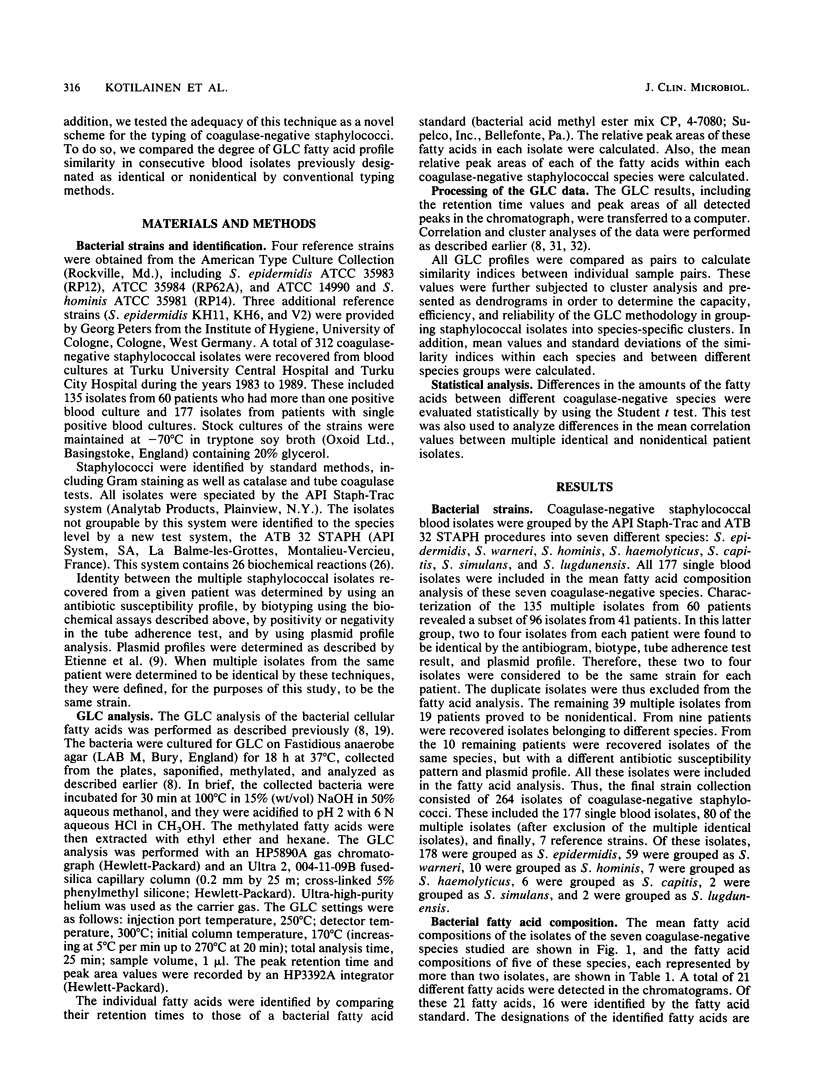

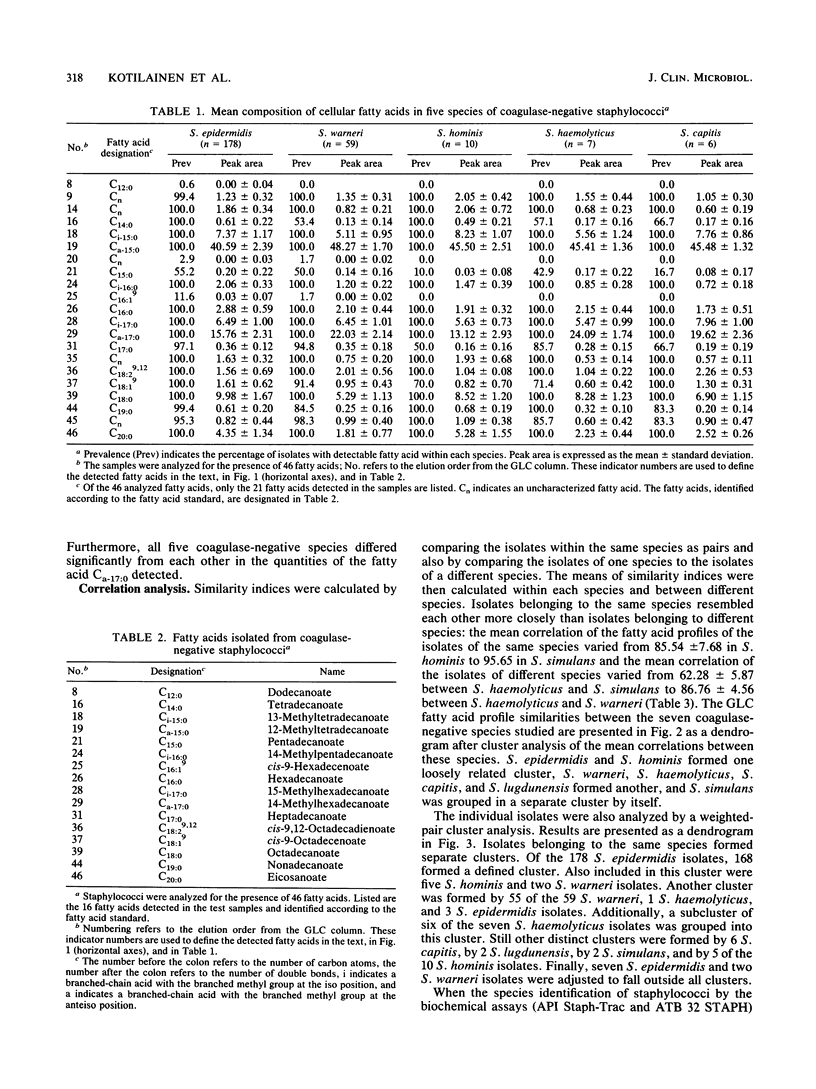
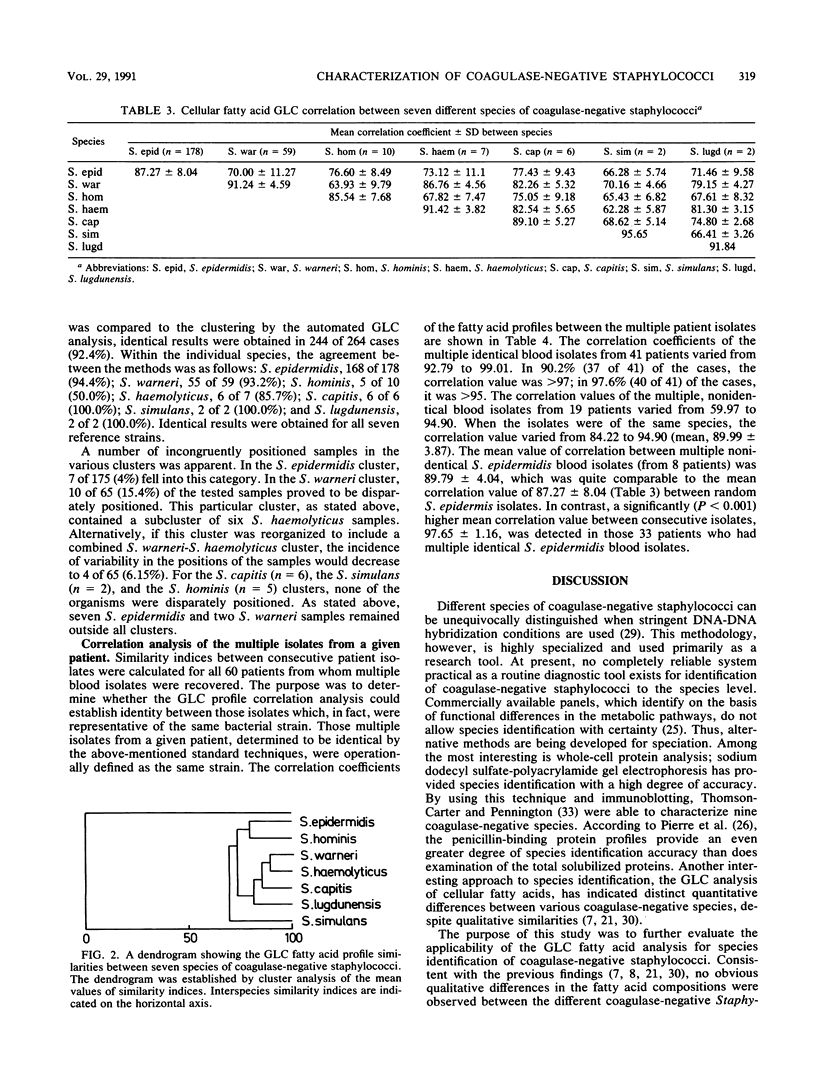
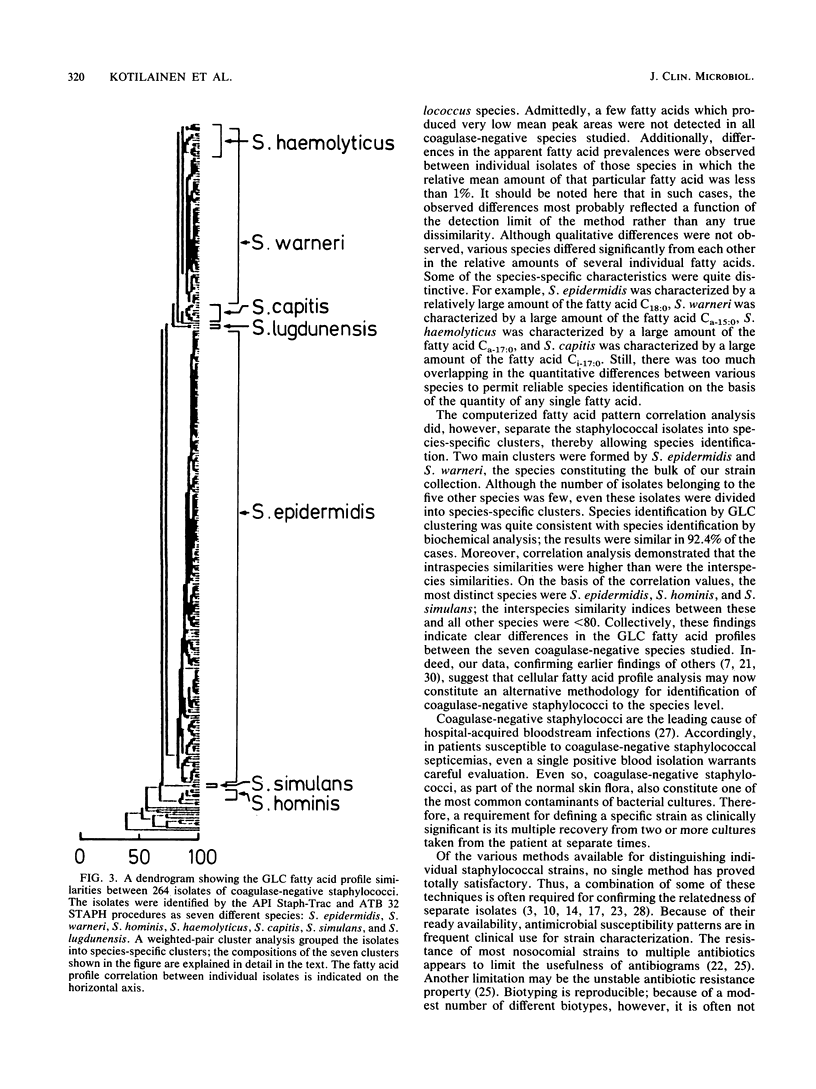
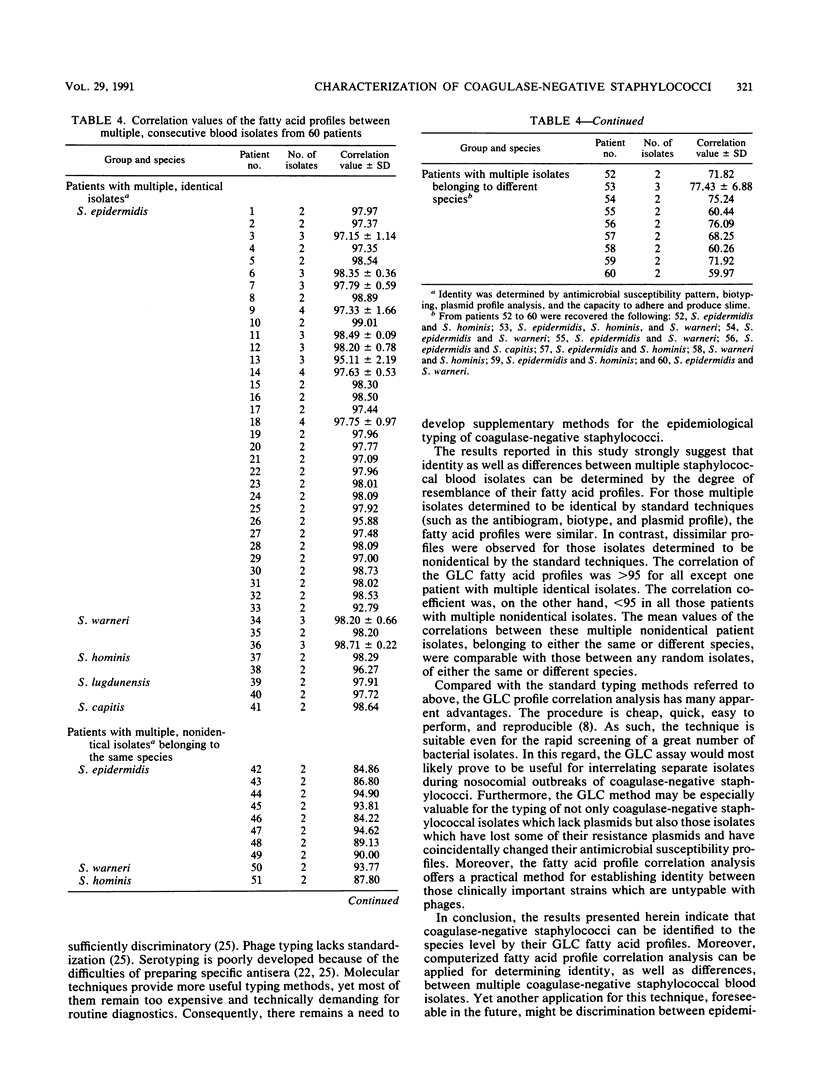
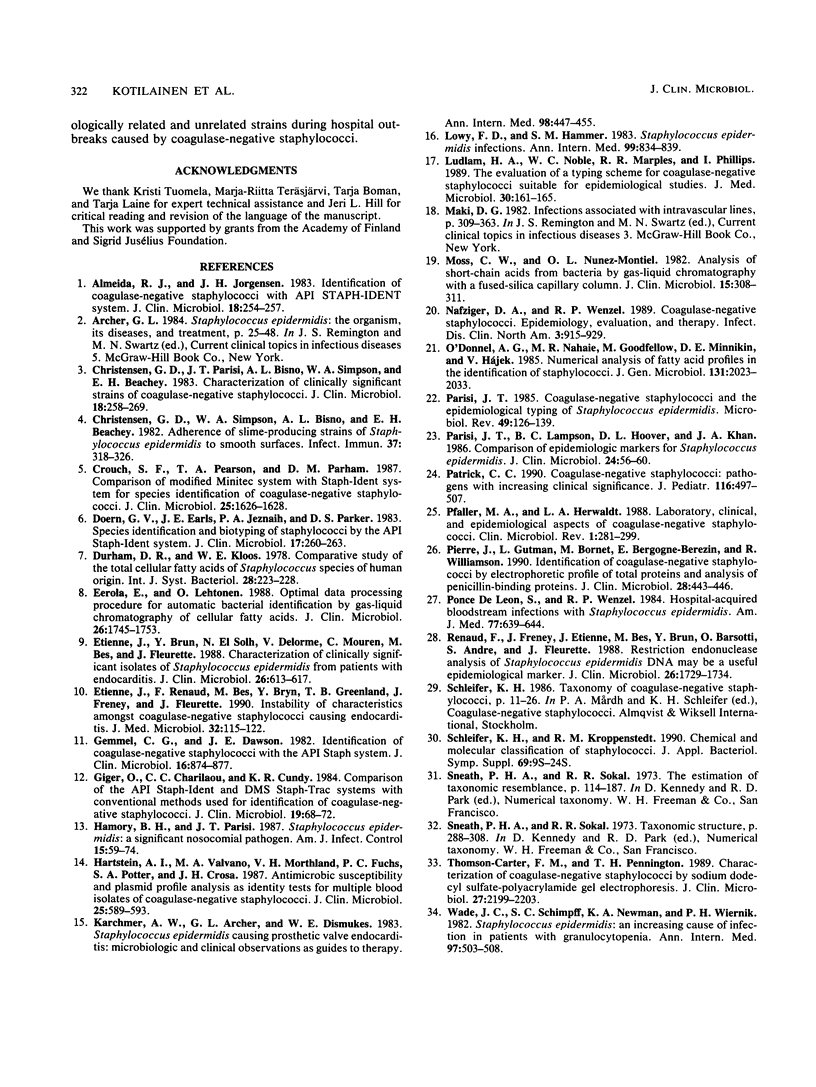
Selected References
These references are in PubMed. This may not be the complete list of references from this article.
- Almeida R. J., Jorgensen J. H. Identification of coagulase-negative staphylococci with the API STAPH-IDENT system. J Clin Microbiol. 1983 Aug;18(2):254–257. doi: 10.1128/jcm.18.2.254-257.1983. [DOI] [PMC free article] [PubMed] [Google Scholar]
- Christensen G. D., Parisi J. T., Bisno A. L., Simpson W. A., Beachey E. H. Characterization of clinically significant strains of coagulase-negative staphylococci. J Clin Microbiol. 1983 Aug;18(2):258–269. doi: 10.1128/jcm.18.2.258-269.1983. [DOI] [PMC free article] [PubMed] [Google Scholar]
- Christensen G. D., Simpson W. A., Bisno A. L., Beachey E. H. Adherence of slime-producing strains of Staphylococcus epidermidis to smooth surfaces. Infect Immun. 1982 Jul;37(1):318–326. doi: 10.1128/iai.37.1.318-326.1982. [DOI] [PMC free article] [PubMed] [Google Scholar]
- Crouch S. F., Pearson T. A., Parham D. M. Comparison of modified Minitek system with Staph-Ident system for species identification of coagulase-negative staphylococci. J Clin Microbiol. 1987 Sep;25(9):1626–1628. doi: 10.1128/jcm.25.9.1626-1628.1987. [DOI] [PMC free article] [PubMed] [Google Scholar]
- Doern G. V., Earls J. E., Jeznach P. A., Parker D. S. Species identification and biotyping of staphylococci by the API staph-ident system. J Clin Microbiol. 1983 Feb;17(2):260–263. doi: 10.1128/jcm.17.2.260-263.1983. [DOI] [PMC free article] [PubMed] [Google Scholar]
- Eerola E., Lehtonen O. P. Optimal data processing procedure for automatic bacterial identification by gas-liquid chromatography of cellular fatty acids. J Clin Microbiol. 1988 Sep;26(9):1745–1753. doi: 10.1128/jcm.26.9.1745-1753.1988. [DOI] [PMC free article] [PubMed] [Google Scholar]
- Etienne J., Brun Y., el Solh N., Delorme V., Mouren C., Bes M., Fleurette J. Characterization of clinically significant isolates of Staphylococcus epidermidis from patients with endocarditis. J Clin Microbiol. 1988 Apr;26(4):613–617. doi: 10.1128/jcm.26.4.613-617.1988. [DOI] [PMC free article] [PubMed] [Google Scholar]
- Etienne J., Renaud F., Bes M., Brun Y., Greenland T. B., Freney J., Fleurette J. Instability of characteristics amongst coagulase-negative staphylococci causing endocarditis. J Med Microbiol. 1990 Jun;32(2):115–122. doi: 10.1099/00222615-32-2-115. [DOI] [PubMed] [Google Scholar]
- Gemmell C. G., Dawson J. E. Identification of coagulase-negative staphylococci with the API staph system. J Clin Microbiol. 1982 Nov;16(5):874–877. doi: 10.1128/jcm.16.5.874-877.1982. [DOI] [PMC free article] [PubMed] [Google Scholar]
- Giger O., Charilaou C. C., Cundy K. R. Comparison of the API Staph-Ident and DMS Staph-Trac systems with conventional methods used for the identification of coagulase-negative staphylococci. J Clin Microbiol. 1984 Jan;19(1):68–72. doi: 10.1128/jcm.19.1.68-72.1984. [DOI] [PMC free article] [PubMed] [Google Scholar]
- Hamory B. H., Parisi J. T., Hutton J. P. Staphylococcus epidermidis: a significant nosocomial pathogen. Am J Infect Control. 1987 Apr;15(2):59–74. doi: 10.1016/0196-6553(87)90003-4. [DOI] [PubMed] [Google Scholar]
- Hartstein A. I., Valvano M. A., Morthland V. H., Fuchs P. C., Potter S. A., Crosa J. H. Antimicrobic susceptibility and plasmid profile analysis as identity tests for multiple blood isolates of coagulase-negative staphylococci. J Clin Microbiol. 1987 Apr;25(4):589–593. doi: 10.1128/jcm.25.4.589-593.1987. [DOI] [PMC free article] [PubMed] [Google Scholar]
- Karchmer A. W., Archer G. L., Dismukes W. E. Staphylococcus epidermidis causing prosthetic valve endocarditis: microbiologic and clinical observations as guides to therapy. Ann Intern Med. 1983 Apr;98(4):447–455. doi: 10.7326/0003-4819-98-4-447. [DOI] [PubMed] [Google Scholar]
- Lowy F. D., Hammer S. M. Staphylococcus epidermidis infections. Ann Intern Med. 1983 Dec;99(6):834–839. doi: 10.7326/0003-4819-99-6-834. [DOI] [PubMed] [Google Scholar]
- Ludlam H. A., Noble W. C., Marples R. R., Phillips I. The evaluation of a typing scheme for coagulase-negative staphylococci suitable for epidemiological studies. J Med Microbiol. 1989 Nov;30(3):161–165. doi: 10.1099/00222615-30-3-161. [DOI] [PubMed] [Google Scholar]
- Moss C. W., Nunez-Montiel O. L. Analysis of short-chain acids from bacteria by gas-liquid chromatography with a fused-silica capillary column. J Clin Microbiol. 1982 Feb;15(2):308–311. doi: 10.1128/jcm.15.2.308-311.1982. [DOI] [PMC free article] [PubMed] [Google Scholar]
- Nafziger D. A., Wenzel R. P. Coagulase-negative staphylococci. Epidemiology, evaluation, and therapy. Infect Dis Clin North Am. 1989 Dec;3(4):915–929. [PubMed] [Google Scholar]
- O'Donnell A. G., Nahaie M. R., Goodfellow M., Minnikin D. E., Hájek V. Numerical analysis of fatty acid profiles in the identification of staphylococci. J Gen Microbiol. 1985 Aug;131(8):2023–2033. doi: 10.1099/00221287-131-8-2023. [DOI] [PubMed] [Google Scholar]
- Parisi J. T. Coagulase-negative staphylococci and the epidemiological typing of Staphylococcus epidermidis. Microbiol Rev. 1985 Jun;49(2):126–139. doi: 10.1128/mr.49.2.126-139.1985. [DOI] [PMC free article] [PubMed] [Google Scholar]
- Parisi J. T., Lampson B. C., Hoover D. L., Khan J. A. Comparison of epidemiologic markers for Staphylococcus epidermidis. J Clin Microbiol. 1986 Jul;24(1):56–60. doi: 10.1128/jcm.24.1.56-60.1986. [DOI] [PMC free article] [PubMed] [Google Scholar]
- Patrick C. C. Coagulase-negative staphylococci: pathogens with increasing clinical significance. J Pediatr. 1990 Apr;116(4):497–507. doi: 10.1016/s0022-3476(05)81593-8. [DOI] [PubMed] [Google Scholar]
- Pfaller M. A., Herwaldt L. A. Laboratory, clinical, and epidemiological aspects of coagulase-negative staphylococci. Clin Microbiol Rev. 1988 Jul;1(3):281–299. doi: 10.1128/cmr.1.3.281. [DOI] [PMC free article] [PubMed] [Google Scholar]
- Pierre J., Gutmann L., Bornet M., Bergogne-Berezin E., Williamson R. Identification of coagulase-negative staphylococci by electrophoretic profile of total proteins and analysis of penicillin-binding proteins. J Clin Microbiol. 1990 Mar;28(3):443–446. doi: 10.1128/jcm.28.3.443-446.1990. [DOI] [PMC free article] [PubMed] [Google Scholar]
- Ponce de Leon S., Wenzel R. P. Hospital-acquired bloodstream infections with Staphylococcus epidermidis. Review of 100 cases. Am J Med. 1984 Oct;77(4):639–644. doi: 10.1016/0002-9343(84)90354-1. [DOI] [PubMed] [Google Scholar]
- Renaud F., Freney J., Etienne J., Bes M., Brun Y., Barsotti O., Andre S., Fleurette J. Restriction endonuclease analysis of Staphylococcus epidermidis DNA may be a useful epidemiological marker. J Clin Microbiol. 1988 Sep;26(9):1729–1734. doi: 10.1128/jcm.26.9.1729-1734.1988. [DOI] [PMC free article] [PubMed] [Google Scholar]
- Schleifer K. H., Kroppenstedt R. M. Chemical and molecular classification of staphylococci. Soc Appl Bacteriol Symp Ser. 1990;19:9S–24S. doi: 10.1111/j.1365-2672.1990.tb01794.x. [DOI] [PubMed] [Google Scholar]
- Thomson-Carter F. M., Pennington T. H. Characterization of coagulase-negative staphylococci by sodium dodecyl sulfate-polyacrylamide gel electrophoresis and immunoblot analyses. J Clin Microbiol. 1989 Oct;27(10):2199–2203. doi: 10.1128/jcm.27.10.2199-2203.1989. [DOI] [PMC free article] [PubMed] [Google Scholar]
- Wade J. C., Schimpff S. C., Newman K. A., Wiernik P. H. Staphylococcus epidermidis: an increasing cause of infection in patients with granulocytopenia. Ann Intern Med. 1982 Oct;97(4):503–508. doi: 10.7326/0003-4819-97-4-503. [DOI] [PubMed] [Google Scholar]


